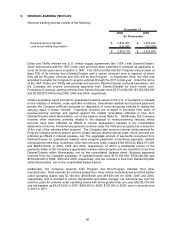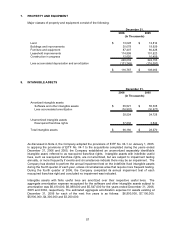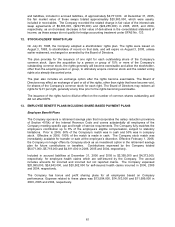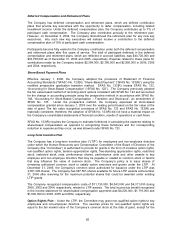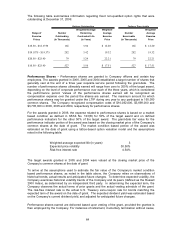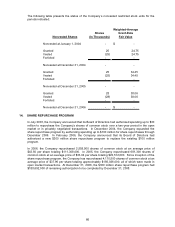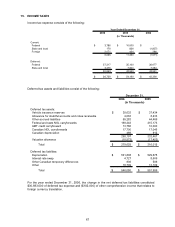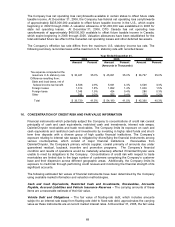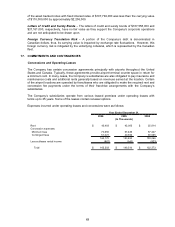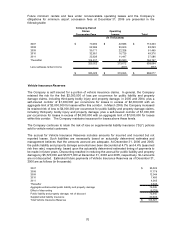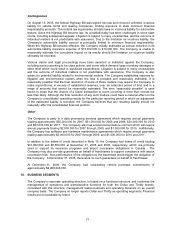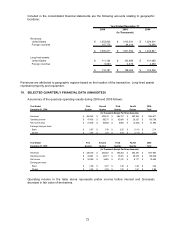Thrifty Car Rental 2006 Annual Report Download - page 68
Download and view the complete annual report
Please find page 68 of the 2006 Thrifty Car Rental annual report below. You can navigate through the pages in the report by either clicking on the pages listed below, or by using the keyword search tool below to find specific information within the annual report.Deferred Compensation and Retirement Plans
The Company has deferred compensation and retirement plans, which are defined contribution
plans that provide key executives with the opportunity to defer compensation, including related
investment income. Under the deferred compensation plan, the Company contributes up to 7% of
participant cash compensation. The Company also contributes annually to the retirement plan.
However, on December 2, 2004, the Company discontinued the retirement plan for any new key
executives. Any such new key executives will instead receive a contribution to the deferred
compensation plan of 15% of participant cash compensation.
Participants become fully vested in the Company contribution under both the deferred compensation
and retirement plans after five years of service. The total of participant deferrals in the deferred
compensation and retirement plans, which are reflected in accrued liabilities, was $40,720,000 and
$32,758,000 as of December 31, 2006 and 2005, respectively. Expense related to these plans for
contributions made by the Company totaled $2,384,000, $2,766,000 and $2,850,000 in 2006, 2005
and 2004, respectively.
Share-Based Payment Plans
Effective January 1, 2006, the Company adopted the provisions of Statement of Financial
Accounting Standards (“SFAS”) No. 123(R), “Share-Based Payment” (“SFAS No. 123(R)”) using the
modified prospective application transition method. SFAS No. 123(R) revises SFAS No. 123,
“Accounting for Stock-Based Compensation” (“SFAS No. 123”). The Company previously adopted
the fair value based method of recording stock options consistent with SFAS No. 123 and accounted
for the change in accounting principle using the prospective method in accordance with SFAS No.
148, “Accounting for Stock-Based Compensation – Transition and Disclosure”, an amendment of
SFAS No. 123. Under the prospective method, the Company expensed all stock-based
compensation granted since January 1, 2003 over the vesting period based on the fair value at the
date of grant. The fair value recognition provisions of SFAS No. 123 and SFAS No. 123(R) are
materially consistent; therefore, the adoption of SFAS No. 123(R) did not have a material impact on
the Company’s consolidated statements of financial condition, results of operations or cash flows.
SFAS No. 123(R) requires the Company to estimate forfeitures in calculating the expense relating to
share-based compensation as opposed to recognizing these forfeitures and the corresponding
reduction in expense as they occur, as was allowed under SFAS No. 123.
Long-Term Incentive Plan
The Company has a long-term incentive plan (“LTIP”) for employees and non-employee directors
under which the Human Resources and Compensation Committee of the Board of Directors of the
Company (the “Committee”) is authorized to provide for grants in the form of incentive option rights,
non-qualified option rights, tandem appreciation rights, free-standing appreciation rights, restricted
stock, restricted stock units, performance shares, performance units and other awards to key
employee and non-employee directors that may be payable or related to common stock or factors
that may influence the value of common stock. The Company’s policy is to issue shares of
remaining authorized common stock to satisfy option exercises and grants under the LTIP. At
December 31, 2006, the Company’s common stock authorized for issuance under the LTIP was
2,081,305 shares. The Company has 527,591 shares available for future LTIP awards at December
31, 2006 after reserving for the maximum potential shares that could be awarded under existing
LTIP grants.
The Company recognized compensation costs of $11,130,000, $4,543,000 and $4,311,000 during
2006, 2005 and 2004, respectively, related to LTIP awards. The total income tax benefit recognized
in the income statement for share-based compensation payments was $4,220,000, $1,719,000 and
$1,590,000 for 2006, 2005 and 2004, respectively.
Option Rights Plan – Under the LTIP, the Committee may grant non-qualified option rights to key
employees and non-employee directors. The exercise prices for non-qualified option rights are
equal to the fair market value of the Company’s common stock at the date of grant, except for the
62






